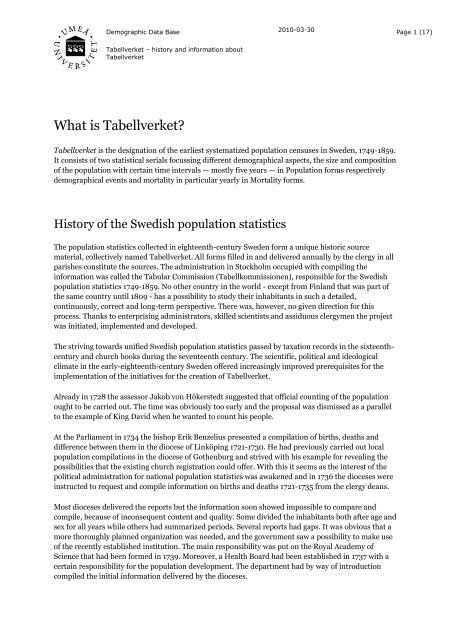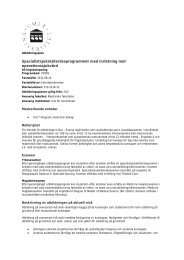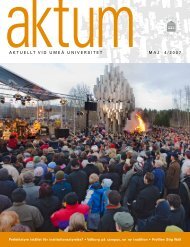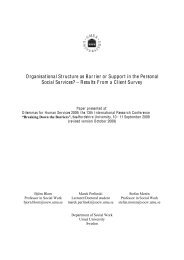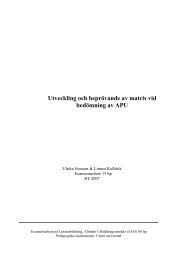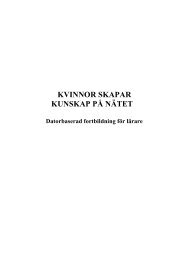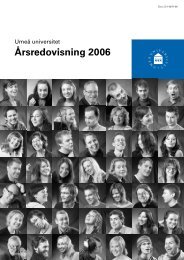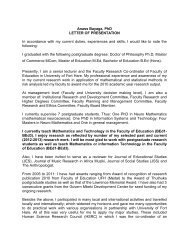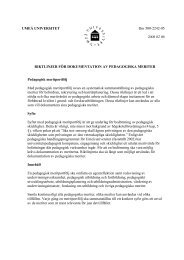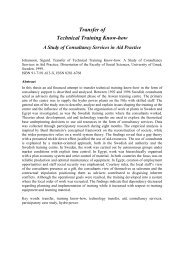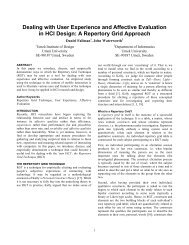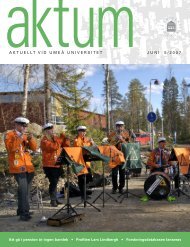Read more about the history behind Tabellverket and its statistical ...
Read more about the history behind Tabellverket and its statistical ...
Read more about the history behind Tabellverket and its statistical ...
Create successful ePaper yourself
Turn your PDF publications into a flip-book with our unique Google optimized e-Paper software.
Demographic Data Base<br />
2010-03-30 Page 1 (17)<br />
<strong>Tabellverket</strong> – <strong>history</strong> <strong>and</strong> information <strong>about</strong><br />
<strong>Tabellverket</strong><br />
What is <strong>Tabellverket</strong><br />
<strong>Tabellverket</strong> is <strong>the</strong> designation of <strong>the</strong> earliest systematized population censuses in Sweden, 1749-1859.<br />
It consists of two <strong>statistical</strong> serials focussing different demographical aspects, <strong>the</strong> size <strong>and</strong> composition<br />
of <strong>the</strong> population with certain time intervals — mostly five years — in Population forms respectively<br />
demographical events <strong>and</strong> mortality in particular yearly in Mortality forms.<br />
History of <strong>the</strong> Swedish population statistics<br />
The population statistics collected in eighteenth-century Sweden form a unique historic source<br />
material, collectively named <strong>Tabellverket</strong>. All forms filled in <strong>and</strong> delivered annually by <strong>the</strong> clergy in all<br />
parishes constitute <strong>the</strong> sources. The administration in Stockholm occupied with compiling <strong>the</strong><br />
information was called <strong>the</strong> Tabular Commission (Tabellkommissionen), responsible for <strong>the</strong> Swedish<br />
population statistics 1749-1859. No o<strong>the</strong>r country in <strong>the</strong> world - except from Finl<strong>and</strong> that was part of<br />
<strong>the</strong> same country until 1809 - has a possibility to study <strong>the</strong>ir inhabitants in such a detailed,<br />
continuously, correct <strong>and</strong> long-term perspective. There was, however, no given direction for this<br />
process. Thanks to enterprising administrators, skilled scientists <strong>and</strong> assiduous clergymen <strong>the</strong> project<br />
was initiated, implemented <strong>and</strong> developed.<br />
The striving towards unified Swedish population statistics passed by taxation records in <strong>the</strong> sixteenthcentury<br />
<strong>and</strong> church books during <strong>the</strong> seventeenth century. The scientific, political <strong>and</strong> ideological<br />
climate in <strong>the</strong> early-eighteenth-century Sweden offered increasingly improved prerequisites for <strong>the</strong><br />
implementation of <strong>the</strong> initiatives for <strong>the</strong> creation of <strong>Tabellverket</strong>.<br />
Already in 1728 <strong>the</strong> assessor Jakob von Hökerstedt suggested that official counting of <strong>the</strong> population<br />
ought to be carried out. The time was obviously too early <strong>and</strong> <strong>the</strong> proposal was dismissed as a parallel<br />
to <strong>the</strong> example of King David when he wanted to count his people.<br />
At <strong>the</strong> Parliament in 1734 <strong>the</strong> bishop Erik Benzelius presented a compilation of births, deaths <strong>and</strong><br />
difference between <strong>the</strong>m in <strong>the</strong> diocese of Linköping 1721-1730. He had previously carried out local<br />
population compilations in <strong>the</strong> diocese of Go<strong>the</strong>nburg <strong>and</strong> strived with his example for revealing <strong>the</strong><br />
possibilities that <strong>the</strong> existing church registration could offer. With this it seems as <strong>the</strong> interest of <strong>the</strong><br />
political administration for national population statistics was awakened <strong>and</strong> in 1736 <strong>the</strong> dioceses were<br />
instructed to request <strong>and</strong> compile information on births <strong>and</strong> deaths 1721-1735 from <strong>the</strong> clergy deans.<br />
Most dioceses delivered <strong>the</strong> reports but <strong>the</strong> information soon showed impossible to compare <strong>and</strong><br />
compile, because of inconsequent content <strong>and</strong> quality. Some divided <strong>the</strong> inhabitants both after age <strong>and</strong><br />
sex for all years while o<strong>the</strong>rs had summarized periods. Several reports had gaps. It was obvious that a<br />
<strong>more</strong> thoroughly planned organization was needed, <strong>and</strong> <strong>the</strong> government saw a possibility to make use<br />
of <strong>the</strong> recently established institution. The main responsibility was put on <strong>the</strong> Royal Academy of<br />
Science that had been formed in 1739. Moreover, a Health Board had been established in 1737 with a<br />
certain responsibility for <strong>the</strong> population development. The department had by way of introduction<br />
compiled <strong>the</strong> initial information delivered by <strong>the</strong> dioceses.
Page 2 (17)<br />
It was mostly members of <strong>the</strong> Academy of Science that played <strong>the</strong> leading roles when <strong>the</strong> general<br />
outlines were laid down for <strong>the</strong> Swedish <strong>Tabellverket</strong>. Archbishop Benzelius became a member in<br />
1740, <strong>and</strong> already from <strong>the</strong> first year <strong>the</strong> astronomer Pehr Elvius had been appointed, in 1744 he<br />
became <strong>the</strong> secretary. On this position <strong>the</strong> man that has been called <strong>the</strong> fa<strong>the</strong>r of Swedish population<br />
statistics - Pehr Wargentin, replaced him at <strong>the</strong> time of his death in 1749.<br />
It was however Pehr Elvius that took <strong>the</strong> first initiatives. In 1744 he published an article in <strong>the</strong> Annales<br />
of <strong>the</strong> Academy of Science with <strong>the</strong> title "Catalogue of <strong>the</strong> annual number of children, that are born in<br />
U… town during <strong>the</strong> last 50 years. With reasons for remarks upon it". The U represented <strong>the</strong> town<br />
Uppsala but this was not allowed to tell, since all population information was made secret because of<br />
<strong>the</strong> (precarious) state of <strong>the</strong> Swedish population should not be known by foreign countries. Well<br />
acquainted with similar works in o<strong>the</strong>r countries Elvius made an estimation of <strong>the</strong> size of <strong>the</strong> Swedish<br />
population. He reached a surprisingly correct number assuming that 2 097 009 persons lived in <strong>the</strong><br />
country. By compiling information from <strong>the</strong> diocese's material he showed that <strong>the</strong> sou<strong>the</strong>rn parts of<br />
Sweden (Götal<strong>and</strong>) were <strong>more</strong> populous than <strong>the</strong> nor<strong>the</strong>rn (Sveal<strong>and</strong>) <strong>and</strong> Finl<strong>and</strong> toge<strong>the</strong>r, that <strong>more</strong><br />
boys than girls were born, that a third of <strong>the</strong> newborn died within three years <strong>and</strong> that except from<br />
children <strong>the</strong> age-group 50-60 years had <strong>the</strong> highest mortality rates.<br />
In 1746 <strong>the</strong> Academy of Science sent Elvius' work to <strong>the</strong> Parliament. But before it was treated ano<strong>the</strong>r<br />
suggestion for increased governmental control over <strong>the</strong> population development had reached <strong>the</strong><br />
Secret Commission. It was a text sent by <strong>the</strong> former military Johan Albrecht von Lantingshausen. He<br />
not only suggested <strong>the</strong> establishment of a national statistics containing information <strong>about</strong> <strong>the</strong><br />
population, but also fur<strong>the</strong>r topics. The proposal included registration of <strong>the</strong> inhabitants after age, sex<br />
<strong>and</strong> civil status. Lantingshausen was convinced that <strong>the</strong> population movement followed given laws,<br />
<strong>and</strong> in order to learn <strong>the</strong> future size of <strong>the</strong> population calculations on marital fertility were needed,<br />
that in turn dem<strong>and</strong>ed information <strong>about</strong> marriages. Four forms were added to <strong>the</strong> text showing <strong>the</strong><br />
structure of <strong>the</strong> suggested registration of monthly notices of births after sex <strong>and</strong> legitimacy <strong>and</strong> <strong>the</strong><br />
number of marriages, deaths after age <strong>and</strong> cause, <strong>and</strong> <strong>the</strong> population after civil status, sex <strong>and</strong> age.<br />
This was <strong>the</strong> basic structure that later formed <strong>Tabellverket</strong>.<br />
There was some disunity when <strong>the</strong> secret Commission discussed von Lantingshausens proposal late<br />
1746. The county governor Gabriel Gyllengrip claimed that already existing information was sufficient,<br />
<strong>and</strong> that a greater ambition never<strong>the</strong>less was not possible to fulfil. Several members were, however,<br />
positive, <strong>and</strong> when <strong>the</strong> strictly secret text from <strong>the</strong> Academy of Science was treated during <strong>the</strong><br />
following year, a majority of <strong>the</strong> members supported <strong>the</strong> suggestions. Plans were now made for <strong>the</strong><br />
proceeding activity concerning <strong>the</strong> establishment of <strong>Tabellverket</strong>.<br />
The compiling of <strong>the</strong> forms was entrusted to four members of <strong>the</strong> Academy of Science, Edvard<br />
Carleson, Ulrik Rudenschiöld, Jacob Faggot <strong>and</strong> Pehr Elvius; <strong>the</strong> later was as already mentioned soon<br />
replaced by Pehr Wargentin. Foggot's son Jacob J. became secretary of <strong>the</strong> committee, a function he<br />
kept during <strong>the</strong> first years of <strong>the</strong> forthcoming Tabular Commission. The men involved with <strong>the</strong> work<br />
with <strong>Tabellverket</strong> had <strong>more</strong> than <strong>the</strong>ir positions in <strong>the</strong> Academy of Science in common. Elvius <strong>and</strong><br />
Wargentin were both astronomers <strong>and</strong> interested in ma<strong>the</strong>matics, several o<strong>the</strong>r members held<br />
positions in <strong>the</strong> state administration. Moreover, <strong>the</strong>y were close friends <strong>and</strong> sometimes also relatives.<br />
This small group with tentacles reaching <strong>the</strong> most important political organs made it possible for <strong>the</strong><br />
Parliament to make a rapid decision concerning <strong>the</strong> establishment of <strong>Tabellverket</strong>.<br />
The main oulines of <strong>Tabellverket</strong> were finally stipulated through <strong>the</strong> Royal decree of 10 November<br />
1748 stating:<br />
Each parish in <strong>the</strong> country should make three tables <strong>and</strong> for this purpose forms were printed <strong>and</strong><br />
delivered. Table I <strong>and</strong> II were printed on <strong>the</strong> same form meaning that <strong>the</strong>re were two different forms.
Page 3 (17)<br />
The first table contained information on <strong>the</strong> number of births, deaths <strong>and</strong> marriages. Table II<br />
contained specific information on deaths after age, sex <strong>and</strong> cause of death. Table III presented <strong>the</strong><br />
population at <strong>the</strong> end of <strong>the</strong> year after age, sex, civil status <strong>and</strong> social class.<br />
According to <strong>the</strong> plan <strong>the</strong> clergy in all parishes should send <strong>the</strong>ir reports crudely in <strong>the</strong> same way as<br />
Lantingshausen had suggested. This was not just an early attempt for national population statistics,<br />
but in <strong>its</strong> details also a very ambitious one.<br />
There was no corresponding strivings in <strong>the</strong> rest of Europe. The Swedish King had taken <strong>the</strong> political<br />
decisions <strong>and</strong> <strong>the</strong> plan was made concrete in 1749, <strong>the</strong> first year included in <strong>the</strong> forms. The<br />
maintaining of <strong>the</strong> collecting of information was, however, not guaranteed by <strong>the</strong> central<br />
administration, because of limited resources. The responsibility lay on <strong>the</strong> clergy, that became <strong>the</strong> true<br />
key persons for Swedish population statistics.<br />
The important role of <strong>the</strong> clergy<br />
During <strong>the</strong> second half of <strong>the</strong> seventeenth century <strong>the</strong> Swedish clergy had been relieved from<br />
involvement in tax <strong>and</strong> military registration. The clergy had all <strong>the</strong> time complained over <strong>the</strong>se duties,<br />
which had made <strong>the</strong>m suspicious in <strong>the</strong> eyes of <strong>the</strong> parishioners. The situation was troublesome, <strong>and</strong><br />
time after time <strong>the</strong> clergy complained to <strong>the</strong> dioceses <strong>and</strong> <strong>the</strong> parliament dem<strong>and</strong>ing relieves in this<br />
part of <strong>the</strong>ir duties. Perhaps was it <strong>the</strong> tight connection between <strong>the</strong> church <strong>and</strong> <strong>the</strong> state that was<br />
decisive for <strong>the</strong> shaping of population statistics in Sweden. The Church Law <strong>its</strong>elf was a state decree,<br />
<strong>and</strong> when <strong>the</strong> new instructions concerning <strong>Tabellverket</strong> were distributed <strong>the</strong>y begun <strong>the</strong>ir work. In<br />
that way <strong>the</strong> Tabular Commission was able to use an organization involving <strong>more</strong> than 2000<br />
clergymen collecting annual information concerning <strong>the</strong> population.<br />
The course of <strong>the</strong> work<br />
In January every year <strong>the</strong> clergyman should send <strong>the</strong> parish forms to <strong>the</strong> dean, who compiled<br />
aggregated forms for his deanery. These were sent to <strong>the</strong> county governors office before <strong>the</strong> end of <strong>the</strong><br />
month (later to <strong>the</strong> diocese) where forms at <strong>the</strong> county level (diocese level) were made. The parish<br />
forms were returned to <strong>the</strong> clergymen. The town council delivered <strong>the</strong> forms for <strong>the</strong> towns. The<br />
dioceses had to send a compilation for each part belonging to different counties to <strong>the</strong> county governor<br />
<strong>and</strong> make a general compilation for <strong>the</strong> diocese. The county governor was responsible for making a<br />
compilation of his county, <strong>and</strong> to send it to <strong>the</strong> Royal Office before <strong>the</strong> end of March. Thus, <strong>the</strong>re were<br />
compilations for both counties <strong>and</strong> dioceses but <strong>the</strong> national surveys kept <strong>the</strong> division of counties.<br />
When <strong>the</strong> county compilations reached Stockholm <strong>the</strong>y were scrutinized by <strong>the</strong> secretary of <strong>the</strong><br />
Tabular Commission, who also made general tables for <strong>the</strong> country.<br />
However, <strong>the</strong> collecting of population data involved problems. The clergy varied in diligence <strong>and</strong> above<br />
all in swiftness to compile <strong>the</strong> information. The forms included obvious scarcities, which soon was<br />
realized by Pehr Wargentin who had been appointed to lead <strong>the</strong> work. The clergy were repeatedly<br />
reminded to be <strong>more</strong> accurate. It was revealed that only minor problems were connected to births,<br />
deaths, marriages <strong>and</strong> migration, while <strong>the</strong> census forms that included age, sex <strong>and</strong> occupational<br />
distribution caused <strong>the</strong> worst inconveniences. The clergy found it difficult to find a relevant category<br />
for all occupations <strong>and</strong> several persons seemed to belong to <strong>more</strong> than one group. The clergy were not<br />
pleased with <strong>the</strong> forms <strong>and</strong> wished that this information should be excluded or at least simplified. In<br />
1752 <strong>the</strong> Parliament decided that <strong>the</strong>se forms should be sent in only every third year, a period that in<br />
1775 was exp<strong>and</strong>ed to five years.
Page 4 (17)<br />
A certain source of error was <strong>the</strong> lack of accordance between <strong>the</strong> administrative <strong>and</strong> <strong>the</strong> ecclesiastical<br />
division of <strong>the</strong> country. The dioceses should make compilations for each part of <strong>the</strong>ir district belonging<br />
to different counties. It happened that some areas were forgotten in this process or were double<br />
registered. In order to remove <strong>the</strong> obstacles it was decided in 1773 that <strong>the</strong> ecclesiastical division<br />
should be followed, meaning that <strong>the</strong> Tabular Commission received compilations at <strong>the</strong> diocese level.<br />
New forms were introduced that instead of three tables contained four, put toge<strong>the</strong>r on two different<br />
forms.<br />
We should not forget that it was <strong>the</strong> continuous work of <strong>the</strong> clergy that guaranteed <strong>the</strong> remaining of<br />
<strong>the</strong> Swedish population statistics. The clergyman was expected to make notices whe<strong>the</strong>r <strong>the</strong> newborn<br />
children were legitimate or not, he should register <strong>the</strong> ages of <strong>the</strong> married couples, he should report all<br />
in- <strong>and</strong> out-migration, he must be aware of <strong>the</strong> different categories of farmers <strong>and</strong> craftsmen, <strong>and</strong><br />
must be able to decide if <strong>the</strong> cause of death was consumption or typhus fever. Most clergymen saw this<br />
as <strong>the</strong>ir duty <strong>and</strong> held <strong>the</strong> responsibility very seriously. Indeed problems remained with deliveries <strong>and</strong><br />
details of <strong>the</strong> forms, but generally <strong>the</strong> clergy did a nice job. The quality of <strong>Tabellverket</strong> is fairly high<br />
<strong>and</strong> reached an extent to which <strong>the</strong>re are no comparisons during <strong>the</strong> eighteenth century.<br />
A period of visions <strong>and</strong> calculations<br />
When <strong>the</strong> compilation of <strong>the</strong> first forms begun all members of <strong>the</strong> Table Commission had o<strong>the</strong>r<br />
permanent positions keeping <strong>the</strong>m busy. Since it was a time-consuming work <strong>and</strong> no extra resources<br />
were available, <strong>the</strong> first general tables for <strong>the</strong> whole of Sweden were not immediately produced. Pehr<br />
Wargentin had - even if his position formerly was equal to those of <strong>the</strong> o<strong>the</strong>r members of <strong>the</strong> Table<br />
Commission - been <strong>the</strong> driving force, <strong>and</strong> it was also he who presented <strong>the</strong> first report to <strong>the</strong> Secret<br />
Commission in 1756. Wargentin argued that Sweden had a reliable population registration, even if he<br />
also observed some remaining deficiencies. Despite <strong>the</strong> fact that some clergymen did not deliver <strong>the</strong>ir<br />
forms in due time, Wargentin had noticed a tendency where teenagers older than 15 years were<br />
reported as younger <strong>and</strong> those close to 60 years were reported as older. The purpose was to avoid tax<br />
registration. An even <strong>more</strong> serious problem was emigration. Wargentin claimed that it ought to be<br />
criminalized.<br />
The central authorities were very pleased with <strong>the</strong> result of <strong>Tabellverket</strong>, <strong>and</strong> concluded that <strong>the</strong>ir<br />
knowledge <strong>about</strong> <strong>the</strong> population was unique compared to o<strong>the</strong>r countries. Still, <strong>the</strong>re were reasons for<br />
worry. It was an obvious conclusion to draw that too few people lived in Sweden compared to <strong>the</strong> space<br />
<strong>and</strong> resources of <strong>the</strong> country. Later during 1756 <strong>the</strong> Table Commission was formerly established as a<br />
new civil service department. The original plan was that it should subordinate to <strong>the</strong> National Board of<br />
Trade, but <strong>the</strong> independence of <strong>the</strong> commission was soon revealed. The only connection between <strong>the</strong><br />
two departments was that some members held double chairs.<br />
From now on a period begun when <strong>the</strong> member of <strong>the</strong> commission <strong>and</strong> <strong>the</strong>ir colleagues compiled,<br />
analysed <strong>and</strong> calculated from <strong>the</strong> extensive <strong>statistical</strong> material that had been collected. Optimism was<br />
great, if not to say enormous. With ma<strong>the</strong>matical methods <strong>the</strong> scientists believed that <strong>the</strong>y now had<br />
had been offered a possibility to catch a glimpse of Sweden in <strong>the</strong> future - where <strong>the</strong> number of blacksmiths<br />
was exactly as great as necessary, where natural resources were ultimately exploited, <strong>and</strong> where<br />
<strong>the</strong> population increasingly grew. The methods that were used were - to say <strong>the</strong> least - not always exact<br />
- estimated <strong>and</strong> insecure values <strong>and</strong> calculations were most often <strong>the</strong> part of <strong>the</strong> results.<br />
Most scholars involved with <strong>the</strong> population statistics in Sweden published <strong>the</strong>ir work in <strong>the</strong><br />
Proceedings of <strong>the</strong> Academy of Science. Jacob Faggot tackled <strong>the</strong> parish of Pernå. He estimated <strong>the</strong><br />
optimal size of acres, <strong>the</strong> best possible population growth-rates, when <strong>the</strong> parishioners ought to get<br />
married <strong>and</strong> a lot of related calculations. Faggot was convinced that <strong>the</strong> transition from <strong>the</strong>ory to<br />
practice was absolutely possible to realize, which would lead to much better living conditions within a
Page 5 (17)<br />
close future. We can here find true utilitarian motives, which - when <strong>the</strong> effect reached all parishes in<br />
Sweden - would increase <strong>the</strong> national strength considerably.<br />
Edvard Runeberg made repeated efforts to estimate <strong>and</strong> divide <strong>the</strong> population in Sweden. How much<br />
bread would <strong>the</strong>y consume, which clo<strong>the</strong>s were needed <strong>and</strong> what was <strong>the</strong> monetary value of a 20 year<br />
old man compared to a 75 year old Runeberg searched <strong>the</strong> answers for such questions with what<br />
appeared to be endless counting exercises. A number of related articles were published in <strong>the</strong><br />
Proceedings, <strong>and</strong> <strong>the</strong> arguing was also included in <strong>the</strong> reports from <strong>the</strong> Table Commission. The<br />
authors <strong>and</strong> <strong>the</strong> Commission expected a strong <strong>and</strong> positive response from <strong>the</strong> Parliament. Political<br />
arithmetic <strong>and</strong> population statistics were seen as important measures, but it was <strong>the</strong> state <strong>its</strong>elf that by<br />
laws, decrees, <strong>and</strong> re-organization must bring <strong>about</strong> <strong>the</strong> real change of <strong>the</strong> society. However, <strong>the</strong><br />
response was not that great, which naturally caused some discouragement.<br />
The most productive <strong>and</strong> influential scientist using <strong>the</strong> new material was Pehr Wargentin. He<br />
published articles in Sweden <strong>and</strong> internationally, <strong>and</strong> is seen as one of <strong>the</strong> most prominent figures in<br />
<strong>the</strong> <strong>history</strong> of population statistics in Sweden. This is, however, mostly true when we talk <strong>about</strong> <strong>the</strong><br />
scientific part of <strong>the</strong> project. Wargentin was not interested in participating in politics. When he worked<br />
with <strong>the</strong> numbers <strong>and</strong> <strong>the</strong> calculations, o<strong>the</strong>r had to take responsibility for <strong>the</strong> work out <strong>the</strong> changes in<br />
practise. The central government was though restrictive to make rapid <strong>and</strong> extensive reforms. What<br />
appeared to be <strong>the</strong>ir greatest concern was <strong>the</strong> fear that <strong>the</strong> information reached o<strong>the</strong>r countries.<br />
Consequently, much of it was made secret which upset Wargentin <strong>and</strong> o<strong>the</strong>r scholars who meant that<br />
an open discussion was necessary.<br />
There were practical problems involved in <strong>the</strong> work of <strong>the</strong> Tabular Commission. Only <strong>the</strong> secretary<br />
received a small salary, <strong>and</strong> during <strong>the</strong> eighteenth he basically had to do all <strong>the</strong> counting <strong>and</strong><br />
summarizing by himself. This meant that <strong>the</strong> production of national statistics took a long time. So<br />
many numbers should be added toge<strong>the</strong>r. Moreover, some clergymen made mistakes o<strong>the</strong>rs were lazy<br />
<strong>and</strong> sent in identical forms several years. The deliverances from <strong>the</strong> dioceses were often delayed which<br />
was even <strong>more</strong> often <strong>the</strong> case with <strong>the</strong> county governors. As mentioned before <strong>the</strong> ambition with <strong>the</strong><br />
census reports had to be lowered, <strong>the</strong>se forms were from 1775 only sent in every fifth year. There were<br />
o<strong>the</strong>r problems too, such as forms being destroyed in fires <strong>and</strong> during sea transports, so some parishes<br />
lacked forms to fill in while o<strong>the</strong>rs had a larger amount. The burden of work was fur<strong>the</strong>r increased at<br />
<strong>the</strong> Tabular Commission when <strong>the</strong> secretary was supposed to survey <strong>the</strong> situation <strong>and</strong> request<br />
information on <strong>the</strong> number of forms available in <strong>the</strong> deaneries.<br />
After <strong>the</strong> report to <strong>the</strong> Parliament in 1772 little was heard from <strong>the</strong> Table Commission for two decades.<br />
No new reports were produced, few articles were published <strong>and</strong> <strong>the</strong> pioneers of <strong>the</strong> 1740s were older.<br />
When <strong>the</strong> members of <strong>the</strong> Table Commission one after <strong>the</strong> o<strong>the</strong>r died, <strong>the</strong>y were not replaced. At <strong>the</strong><br />
end of <strong>the</strong> 1780s it seemed as <strong>the</strong> entire project would come to nothing. But new strength was found,<br />
new persons became involved with <strong>the</strong> work <strong>and</strong> population statistics slowly recovered.<br />
In 1791 Henric Nic<strong>and</strong>er was appointed new secretary of <strong>the</strong> Tabular Commission. He, like Wargentin<br />
<strong>and</strong> Elvius, had his scientific roots in astronomy. Nic<strong>and</strong>er immediately begun to scrutinize <strong>the</strong> stock<br />
of forms in Stockholm <strong>and</strong> found large gaps. Some parts of <strong>the</strong> country had not reported for many<br />
years <strong>and</strong> o<strong>the</strong>rs where sitting <strong>and</strong> waiting to receive new forms. The military in Stockholm had not<br />
delivered forms before 1757 <strong>and</strong> <strong>the</strong> town of Karlskrona hade not sent any census forms before 1772.<br />
Even until 1805 <strong>the</strong> size of <strong>the</strong> population in Karlskrona had to be estimated from o<strong>the</strong>r information.<br />
Nic<strong>and</strong>ers' efforts to collect <strong>the</strong> missing information<br />
When a new edition of <strong>the</strong> forms was printed in 1793 it was decided that <strong>the</strong> dioceses should send <strong>the</strong><br />
deanery forms directly to <strong>the</strong> Tabular Commission. Copies were made <strong>and</strong> kept at <strong>the</strong> diocese. This<br />
facilitated <strong>the</strong> control <strong>and</strong> eventual complements of <strong>the</strong> material. These changes was a great step
Page 6 (17)<br />
towards a centralization of <strong>the</strong> population statistics. The work of <strong>the</strong> commission became considerably<br />
<strong>more</strong> extensive <strong>and</strong> additional resources were given.<br />
In 1858 <strong>the</strong> Statistical Bureau was established. It overtook <strong>the</strong> responsibility for <strong>the</strong> Swedish<br />
population statistics <strong>and</strong> <strong>the</strong> work soon involved a lot of o<strong>the</strong>r statistics than merely demographic.<br />
However, no important changes in <strong>the</strong> collecting of information had preceded <strong>the</strong> establishment of <strong>the</strong><br />
bureau. The content of <strong>the</strong> form had varied during <strong>the</strong> nineteenth century. In 1802, for example, <strong>the</strong>re<br />
were changes in <strong>the</strong> age categories, <strong>and</strong> between 1831 <strong>and</strong> 1859 <strong>the</strong> forms contained only three causes<br />
of death; smallpox, stillbirths <strong>and</strong> accidents. The thought was that <strong>the</strong> physicians should be<br />
responsible for this kind of statistics, which was never realized. The clergy, on <strong>the</strong> o<strong>the</strong>r h<strong>and</strong>, that had<br />
been relieved from a heavy burden, were instructed to add information <strong>about</strong> wea<strong>the</strong>r conditions,<br />
diseases among <strong>the</strong> cattle <strong>and</strong> economic status of <strong>the</strong> dead.<br />
Under <strong>the</strong> administrative leadership of Henric Nic<strong>and</strong>er <strong>and</strong> his successor from 1815, John Adolf<br />
Leyonmarck, an organization developed that kept <strong>the</strong> collecting of population data in firm shape. They<br />
rescued <strong>the</strong> heritage from <strong>the</strong> eighteenth century <strong>and</strong> kept <strong>the</strong> series of information unbroken. That is<br />
why we today - <strong>more</strong> than 250 years later - can state that Sweden actually has <strong>the</strong> oldest population<br />
statistics in <strong>the</strong> world.<br />
Contents in <strong>Tabellverket</strong><br />
The term <strong>Tabellverket</strong> refers to <strong>the</strong> design of <strong>the</strong> pre-printed sheets to be filled-in by <strong>the</strong> clergymen,<br />
namely forms with lots of tables on different <strong>the</strong>mes. The fundamental tables of all <strong>the</strong> Population<br />
forms contain information <strong>about</strong> <strong>the</strong> population by age, sex <strong>and</strong> civil status <strong>and</strong>, in addition, <strong>its</strong><br />
distribution by social status or occupation according to a classification which reveals notable changes<br />
over time.<br />
In <strong>the</strong> Mortality forms, <strong>the</strong> basic tables consistently refer to deaths by age, sex <strong>and</strong> civil status, <strong>and</strong> also<br />
by causes of death classified in different ways over time, which likewise requires attention. The<br />
remaining demographical events, fertility <strong>and</strong> nuptiality, are represented in different ways meaning a<br />
gradual increase of variables over time. Initially, merely <strong>the</strong> number of events such as births by<br />
legitimacy, multiple births, marriages <strong>and</strong> dissolved marriages exists. But, later on <strong>more</strong> details are at<br />
h<strong>and</strong>; for instance, mo<strong>the</strong>rs by age <strong>and</strong> economic conditions, <strong>and</strong> married spouses by age or age<br />
difference, social status <strong>and</strong> ordinal number at marriage.<br />
Migration statistics from <strong>the</strong> 19th century can be obtained from ei<strong>the</strong>r Population forms or Mortality<br />
forms, in terms of in- <strong>and</strong> out-migrations or net migrations, yearly or summed for periods of five<br />
years. Hence, <strong>the</strong>re are shortcomings in comparability over time. In addition, migration statistics is<br />
missing in forms from <strong>the</strong> 18th century.<br />
Pay attention to <strong>the</strong> possibilities for cross-controls of contents between forms <strong>and</strong>/or for replacement<br />
in case of missing data. In one <strong>and</strong> <strong>the</strong> same form population size <strong>and</strong> demographical events by sex<br />
may exist for <strong>the</strong> same geographical area at a previous date to that of <strong>the</strong> form, <strong>and</strong>, for o<strong>the</strong>r areas at<br />
<strong>the</strong> same date as well. Fur<strong>the</strong>r<strong>more</strong>, summary information might be included in one form for <strong>the</strong> o<strong>the</strong>r<br />
type of form for <strong>the</strong> same area referring to <strong>the</strong> same year <strong>and</strong>/or previous years. These possibilities are<br />
at h<strong>and</strong> by usage of <strong>the</strong> information existing in <strong>the</strong> form tables called Calculus tables <strong>and</strong> Specification<br />
tables in most Population <strong>and</strong> Mortality forms from <strong>the</strong> 19th century.
Page 7 (17)<br />
In addition, <strong>the</strong>re is statistics concerning miscellaneous conditions, sometimes occasionally; for<br />
instance <strong>about</strong> households. A <strong>more</strong> detailed presentation of <strong>the</strong> content in <strong>the</strong> forms as well as<br />
temporal changes in information between <strong>the</strong> form editions is given in separate parts.<br />
Geographical areas for population statistics<br />
The population statistics in <strong>the</strong> Tabellverk should be produced for areas at <strong>the</strong> lowest level of <strong>the</strong><br />
ecclesiastical administration, <strong>the</strong> parish (församling), <strong>and</strong> <strong>the</strong>reafter be aggregated into larger<br />
administrative un<strong>its</strong> within <strong>the</strong> ecclesiastical as well as <strong>the</strong> civil hierarchy. This procedure was,<br />
however, not an easy task, since spatial differences existed between <strong>the</strong> two types of administrative<br />
divisions, event though <strong>the</strong> smallest ecclesiastical unit, <strong>the</strong> parish, mostly constituted <strong>the</strong> same area as<br />
<strong>the</strong> smallest civil unit, (socken/jordebokssocken).<br />
The printed instructions in <strong>the</strong> forms to be filled in by <strong>the</strong> clergyman bear witness to an awareness of<br />
<strong>the</strong>se spatial deviations in divisions. During <strong>the</strong> 18th century <strong>the</strong> instructions explicitly stated that <strong>the</strong><br />
ecclesiastical division was to be followed. But, during <strong>the</strong> 19th century modifications were made in<br />
order to allow for an aggregation on <strong>the</strong> civil administrative county level (län) <strong>and</strong> a separation<br />
between rural <strong>and</strong> urban areas. Therefore, Parts of a parish were to be reported on <strong>the</strong>ir own in <strong>the</strong><br />
Population <strong>and</strong> Mortality forms during <strong>the</strong> following conditions: All <strong>the</strong> parishioners did not belong to<br />
one <strong>and</strong> <strong>the</strong> same county (<strong>the</strong> civil administrative unit län), or, <strong>the</strong> parish contained both an urban <strong>and</strong><br />
a rural population.<br />
Hence, an ecclesiastical rural parish, parts of which were located in different counties, should no<br />
longer be reported as one <strong>statistical</strong> unit, but as un<strong>its</strong> equivalent to <strong>the</strong> number of counties involved.<br />
All forms from year 1802 onwards include such instructions.<br />
Fur<strong>the</strong>r<strong>more</strong>, <strong>the</strong> judicial urban population within a mixed urban-rural parish should be described<br />
separately from <strong>the</strong> non-urban population in <strong>the</strong> same parish. This last mentioned instruction is to be<br />
seen in <strong>the</strong> context of production of specific Population forms from 1805 for urban areas. But note, in<br />
<strong>the</strong> Mortality forms this instruction was not mentioned until 1821.<br />
Population<br />
By tradition an ecclesiastical as well as a civil population registration has existed in Sweden. Civil tax<br />
registers were made at a specific date yearly, for payers of <strong>the</strong> personal poll taxes in mid 18th century<br />
<strong>and</strong> later on for all <strong>the</strong> population in <strong>the</strong> administrative unit socken (cf <strong>the</strong> part concerning<br />
Geographical areas). The ecclesiastical population registration can be described as a kind of<br />
continuous population census kept in Church Examination Registers for <strong>the</strong> parishioners,<br />
supplemented by separate registers for demographical events such as births, deaths, marriages <strong>and</strong>,<br />
later on, in- <strong>and</strong> out-migrations. There was a high degree of interaction between <strong>the</strong>se two types of<br />
registration. The civil registers were based upon <strong>the</strong> ecclesiastical registers, <strong>and</strong>, <strong>the</strong> clergymen were<br />
supposed to assist in drawing up <strong>the</strong> poll tax registers.<br />
The population to be reported in forms in <strong>Tabellverket</strong> was <strong>the</strong> parishioners. It is clearly stated in<br />
instructions printed in <strong>the</strong> forms from <strong>the</strong> 18th century. The population concerned is <strong>the</strong> one existing<br />
in <strong>the</strong> Church Examination Registers; <strong>the</strong> basic source for <strong>the</strong> statistics in <strong>the</strong> Tabellverk, which, if<br />
necessary, should be updated with information from <strong>the</strong> civil poll-tax registers.<br />
This definition of population was also printed in <strong>the</strong> instructions to <strong>the</strong> Population forms 1749-1772:<br />
"no one else than those who really were resident in <strong>the</strong> parish or at least spent most of <strong>the</strong> year in <strong>the</strong><br />
parish" (free translation). Elsewhere in <strong>the</strong>se instructions it was also mentioned that <strong>the</strong> age
Page 8 (17)<br />
distribution of <strong>the</strong> population should be constructed from conditions at date for <strong>the</strong> church<br />
examinations; in fact meaning not one particular day during <strong>the</strong> year in question! This calculation,<br />
<strong>the</strong>refore, had to be updated with information <strong>about</strong> births, deaths <strong>and</strong> migrations taken place later on<br />
during <strong>the</strong> year in question. The urban population, however, was to be calculated house by house by<br />
civil officials, which in turn should inform <strong>about</strong> <strong>the</strong> results to <strong>the</strong> clergyman in charge of filling-in <strong>the</strong><br />
form. Such instructions were also applied in <strong>the</strong> forms 1775-1800.<br />
Later on, <strong>the</strong> instructions became <strong>more</strong> detailed regarding how to update <strong>the</strong> information in <strong>the</strong><br />
Church Examination Registers as well as how to deal with certain groups of individuals. The meaning<br />
of <strong>the</strong>se instructions was clearly an increased usage of information from <strong>the</strong> civil poll-tax registration.<br />
All Population forms for rural parishes 1805-1850 contain an explicit dem<strong>and</strong> for additional<br />
information from officials in charge for poll-tax registration. For urban parishes, <strong>the</strong> earlier issued<br />
directives maintained, but <strong>the</strong> actual calculation was based upon <strong>the</strong> poll-tax registers, not on actual<br />
counting house by house.<br />
Fur<strong>the</strong>r<strong>more</strong>, <strong>the</strong> membership of civil administrative unit at <strong>the</strong> end of <strong>the</strong> year was given precedence<br />
as for new born children, for employed at estates - regardless of residence of <strong>the</strong> employer -, for<br />
members of <strong>the</strong> armed forces <strong>and</strong> for absent sailors, according to instructions 1840 onwards. But, for<br />
those individuals, who did not have a permanent residence, <strong>the</strong> location should be decided with<br />
reference to <strong>the</strong> parish in which <strong>the</strong> individual got pastoral cure (Instructions in Mortality forms 1831-<br />
1859).
Page 9 (17)<br />
Biographical Guide<br />
Literature concerning <strong>the</strong> <strong>history</strong> of Swedish population statistics<br />
A considerable amount of articles <strong>and</strong> books have been written concerning <strong>the</strong> <strong>history</strong> of Swedish<br />
population statistics. The present compilation includes a limited number of those sources <strong>and</strong><br />
references that are available. In order to improve <strong>the</strong> lucidity <strong>the</strong> survey has been arranged after <strong>the</strong><br />
following model:<br />
Public documents<br />
H<strong>and</strong>books<br />
Ordinances<br />
Instructions<br />
Printed sources<br />
Annales of <strong>the</strong> Royal Swedish Academy of Science<br />
Printed sources: The era of <strong>the</strong> Tabular Commission<br />
Printed sources: The era of <strong>the</strong> Statistical Bureau<br />
References<br />
Sweden, generally<br />
Journal of Statistics (Statistisk Tidskrift)<br />
Journal of Political Science (Statsvetenskaplig Tidskrift)<br />
International<br />
Public records<br />
National Archives - Archive of <strong>the</strong> Royal Office<br />
National Archives - Archive of <strong>the</strong> Tabular Commission<br />
Public documents<br />
H<strong>and</strong>books<br />
The eighteenth-century Swedish clergy did not have much literature available for improving <strong>the</strong>ir<br />
knowledge <strong>and</strong> skill concerning <strong>the</strong> information included in <strong>the</strong> forms of <strong>Tabellverket</strong>. Certainly<br />
printed instructions were included in <strong>the</strong> forms, but except of this <strong>the</strong>re were no h<strong>and</strong>books. A major<br />
difficulty for <strong>the</strong> clergy was <strong>the</strong> causes of deaths. Thus, <strong>the</strong>re was some literature <strong>the</strong> clergy could<br />
consult in order to learn <strong>more</strong> <strong>about</strong> diseases <strong>and</strong> health. We must remember that <strong>the</strong> clergyman often<br />
had to give <strong>the</strong> parishioners practical advice in medical matters, giving him fur<strong>the</strong>r reasons reading <strong>the</strong><br />
available information.<br />
Haartman, Joh. Hohson (1963 [1765]). M.G.S. Tydelig Underrättelse, Om de Mäst Gångbara<br />
Sjukdomars Känn<strong>and</strong>e och Mot<strong>and</strong>e, Genom Lätta och Enfalliga Hus-Medel; Samt et litet Res- och<br />
Hus-Apo<strong>the</strong>k; Dem til tjenst som ej hafwa tilfälle at rådfråga Läkare, Med åtskilliga förbätringar<br />
och tilökningar. Andra upplagan. Uppsala.<br />
Rosén von Rosenstein, N. (1990 [1764]). Underrättelser om Barnsjukdomar och deras Bote-Medel:<br />
Tilförne styckewis utgifne uti de små Almanachorna, nu samlade, tilökte och förbättrade. Facsimile<br />
in Jägervall, M. (1990). Nils Rosén von Rosenstein och hans lärobok i pediatrik. Lund.<br />
Rydén, A. J. (1846). Sveriges kyrkolag af år 1686; jemte ännu gäll<strong>and</strong>e stadg<strong>and</strong>en, genom hvilka<br />
den blifvit ändrad eller tillökt. Jönköping.<br />
Wåhlin, Christian (1807). H<strong>and</strong>bok uti Svenska Kyrko Lagfarenheten, innefatt<strong>and</strong>e samm<strong>and</strong>rag af<br />
alder och nyare Kongeliga Författningar samt <strong>and</strong>re stadgar om prediko embetets förvaltning; til<br />
vägledning för unge prästmän. Lund.
Page 10<br />
(17)<br />
Ordinances<br />
Beskow, Wilhelm (1894). Kyrkobokföringen och därmed sammanhäng<strong>and</strong>e stadg<strong>and</strong>en. Stockholm:<br />
Ivar Hæggström.<br />
Instructions<br />
Kongl. Tabell-Commissionens Cirkulär af d. 31 October 1810, Innehåll<strong>and</strong>e Föreskrifter och<br />
Förklaringar angående Tabell-Formulärerne. Strengnäs: Albrect Julius Segerstedt 1810.<br />
Printed sources<br />
Annales of <strong>the</strong> Royal Swedish Academy of Science<br />
1744 (V)<br />
(4) Elvius, Pehr. Förtekning uppå Barnens årliga antal som äro födde uti U…. Stad under de sist<br />
förflutne 50 åren. Jemte anledning til anmärkningar deröfver, 293-300.<br />
1754 (XV)<br />
(3) Wargentin, Pehr. Anmärkningar Om nyttan af årliga Förtekningar på födda och döda i et l<strong>and</strong>, 161-<br />
72.<br />
(4) Wargentin, Pehr. Anmärkningar Om nyttan af årliga Förtekningar på födda och döda i et l<strong>and</strong>, 241-<br />
54.<br />
1755 (XVI)<br />
(1) Wargentin, Pehr. Fortsättning af Anmärkningarna om Nyttan af årliga Förtekningar på födda och<br />
döda i et l<strong>and</strong>, 1-15.<br />
(2) Wargentin, Pehr. Anmärkningar Om nyttan af årliga Förtekningar på födda och döda i et l<strong>and</strong>,<br />
Fjärde stycket, 81-96.<br />
(3) Wargentin, Pehr. Anmärkningar Om nyttan af årliga Förtekningar på födda och döda i et l<strong>and</strong>,<br />
Femte stycket, 161-70.<br />
(4) Wargentin, Pehr. Anmärkningar Om nyttan af årliga Förtekningar på födda och döda i et l<strong>and</strong>,<br />
Sjette stycket, 241-53.<br />
1758 (XIX)<br />
(2) Runeberg, Ephraim Otto. Beskrifning öfver Lajhela Socken i Österbotten, 108-62.<br />
1759 (XX)<br />
(3) Runeberg, Ephraim Otto. Försök Til en Politisk Värdering på L<strong>and</strong> och Folk, i anledning af Laihela<br />
Socken, 187-98.<br />
1764 (XXV)<br />
(2) Runeberg, Edvard Fredric. Om Svea rikes Folk-nummer och Naturliga Styrka, 81-115.<br />
1765 (XXVI)<br />
(4) Runeberg, Edvard Fredric. Fortsättning af K. Tabell-Commissionens Anmärkningar Om Svenska<br />
Folkhopens fördelning, i anseende til ålder och kön, 274-89.<br />
1766 (XXVII)<br />
(1) Wargentin, Pehr. Mortaliteten i Sverige, i anledning af Tabell-Verket, 1-25.<br />
1767 (XXVIII)<br />
(3) Runeberg, Edvard Fredric. Fortsättning af Kongl. Tabell-Commissionens Anmärkningar Om<br />
Svenska Folkhopens Politiska fördelning eller skillnader i anseende til stånden, 209-44.
Page 11<br />
(17)<br />
(4) Wargentin, Pehr. Uti hvilka Månader flera Människor årligen födas och dö i Sverige, 249-58.<br />
1769 (XXX)<br />
(1) Wargentin, Pehr. Om Stockholms Stads tilväxt i Folkrikhet, ifrån år 1721, til och med 1766, 3-12.<br />
1770 (XXXI)<br />
(2) Runeberg, Eduard Fredric. Fortsättning Af Kongl. Tabell-Commissionens Oeconimiska<br />
Anmärkningar, och särdeles om L<strong>and</strong>tbruket, samt den därvid arbet<strong>and</strong>e Folkhopen, 130-51.<br />
1774 (XXXV)<br />
(3) Wargentin, Pehr. Om Carlstads Stifts tilväxt i Folkriket, sedan år 1721, 258-65.<br />
The New Annales of <strong>the</strong> Royal Swedish Academy of Science<br />
1780 (I)<br />
(4) Wargentin, Pehr. Undersökning om Folk-Utflyttningen, så väl utur hela Riket, som utur hvart<br />
Höfdingedöme särskilt, i anledning af Tabell-verket för åren 1750, til och med 1773, 243-65.<br />
1782 (III)<br />
(3) Wargentin, Pehr. Folkmängden uti hela Riket och uti hvart Höfdingedöme, tillika med Hushållens<br />
antal i Städerne och på L<strong>and</strong>et, sådane som de af Tabell-verket befunn<strong>its</strong>, åren 1751 och 1772, med<br />
korrta anmärkningar, 236-44.<br />
1799 (XX)<br />
(3) Nic<strong>and</strong>er, Henric. Om Tabell-Värkets Tillstånd i Sverige och Finl<strong>and</strong> ifrån 1772 till och med 1795.<br />
I:a Afh<strong>and</strong>l. Angående årliga Förhåll<strong>and</strong>et imellan Födde och Döde, 152-62 (+tab.).<br />
(4) Nic<strong>and</strong>er, Henric. Om Tabell-Värkets Tillstånd i Sverige och Finl<strong>and</strong> ifrån 1772 till och med 1795.<br />
2:dra Afh<strong>and</strong>l. Angående Folk-Numern, 239-56 (+tab.).<br />
Printed sources - The era of <strong>the</strong> Tabular Commission<br />
H<strong>and</strong>lingar angående Tabell-verket. Stockholm: A. Gadelius 1818.<br />
Kryger, Johan Fredric (1758). Tal om Folkbristens Orsaker, Verkan och Hjelp; Hållit för Kongl.<br />
Vetenskaps-Academien vid præsidii nedlägg<strong>and</strong>e den 10 Maji, år 1758. Stockholm: Lars Salvius.<br />
Runeberg, Edvard Fredric (1778). Tal, om nyttan och angelägenheten af Hushålls-kunskapens<br />
bring<strong>and</strong>e til en Vetenskap; hållit för Kongl. Vetenskaps-Academien, vid præsidii nedlägg<strong>and</strong>e, den 5<br />
Aug. 1778. Stockholm: Johan Georg Lange.<br />
Säf, Matthias. Wissa Wetenskapers Nödvändighet För Tabell-Wärket. Uppsala: Kongl. Acad. Boktr.<br />
1754.<br />
Till ÖfwerStåthållaren, om upgifter till Tabell-Commissionen, rör<strong>and</strong>e i hufwudstaden bosatte<br />
personer af främm<strong>and</strong>e religionslära. (Till L<strong>and</strong>shöfdingarne i Gö<strong>the</strong>borgs och Bohus-, i<br />
Östergöthl<strong>and</strong>s-, samt i Blekinge Län: om enah<strong>and</strong>a föreskrift i anseende på städerne Gö<strong>the</strong>borg,<br />
Norrköping och Carlscrona). Stockholm den 19 Januarii 1825. Swensk Författnings-Samling. Första<br />
Årgången, 1825 (1825). Stockholm: Kongl. Tryckeriet, 15-16<br />
Wargentin, Pehr (1815). Afh<strong>and</strong>ling om Menniskans lifstid, meed åtfölj<strong>and</strong>e Tabell, som wisar den<br />
medelmåttiga Lefnadslängd, hwartill Menniskorna i allmänhet gemenligen hinna öfwer wissa<br />
framlefda år. Gagnelig wid Lifstids-Räntors, Förpantningars och Donationers upprätt<strong>and</strong>e.<br />
Stockholm: Fr. Cederborgh.<br />
Wargentin, Pehr (1903). Självbiografiska anteckningar. Historisk Tidskrift (23): 155-71.
Page 12<br />
(17)<br />
Wargentin, Pehr (1930). Mortality in Sweden according to <strong>the</strong> "Tabell-Verket" (General Register<br />
Office). Stockholm: Thule Life Insurance Company.<br />
Printed sources - The era of <strong>the</strong> Statistical Bureau<br />
Underdånigt betänk<strong>and</strong>e och förslag rör<strong>and</strong>e inrätt<strong>and</strong>et af ett Statistiskt Embetsverk, afgifvet den 18<br />
juni 1856 af den dertill i nåder förordnade komité. Stockholm: Hörbergska 1856.<br />
Wicksell, Sven (1922). Bilaga till statistiksakkunnigas betänk<strong>and</strong>e. Redogörelse för huvuddragen av<br />
den officiella statistikens utveckling och nuvar<strong>and</strong>e organisation i Sverige jämte kort översikt av dess<br />
organisation i vissa främm<strong>and</strong>e länder samt i internationellt hänseende. Statens Offentliga<br />
Utredningar 1922:50. Stockholm: Finansdepartementet.<br />
Referenser<br />
Sweden, generally<br />
Arosenius, E. (1928). Bidrag till det svenska <strong>Tabellverket</strong>s historia. Stockholm, P. A. Norstedt & söner.<br />
Cederberg, A. R. (1919). Pehr Wargentin als statistiker. Untersuchungen in der Geschichte der<br />
Bevölkerungsstatistik während der zweiten Hälfte des 18. Jahrhunderts. Helsinki: Suomelaisen<br />
Tiedeakatemian Kustantama. Annales Academiæ Scientiarum Fennicæ, B IV:4.<br />
Friberg, Nils (1974). <strong>Tabellverket</strong> och de fullständiga mantallängderna från 1700-talet. Stockholm:<br />
Kulturgeografiska Institutionen, Stockholms Universitet.<br />
Fritzell, Yngve (1951). Det svenska tabellverket. Svenska Kalendern 1951. En årsbok för alla 46.<br />
Uppsala: Almqvist & Wiksell, 239-52.<br />
Fritzell, Yngve (1973). Yrkesfördelningen 1840-1855 enligt <strong>Tabellverket</strong> jämfört med <strong>and</strong>ra källor.<br />
Statistisk Tidskrift, 11(5): 358-95.<br />
Fritzell, Yngve (1976). Yrkesfördelningen 1825-1835 enligt <strong>Tabellverket</strong> och <strong>and</strong>ra källor. Statistisk<br />
Tidskrift, 14(3): 181-229.<br />
Fritzell, Yngve (1980). Yrkesfördelningen 1805-1820 enligt <strong>Tabellverket</strong> och <strong>and</strong>ra källor jämte<br />
samm<strong>and</strong>rag intill 1855. Statistisk Tidskrift, 18(1): 5-69.<br />
Fritzell, Yngve (1983). Yrkesfördelningen 1753-1805 enligt <strong>Tabellverket</strong>: de särskilda städerna.<br />
Statistisk Tidskrift, 21(4): 279-325.<br />
Gahn, Hans (1915). Moralstatistiska uppgifter i Frihetstidens Tabellverk. En demografisk studie.<br />
Uppsala: K. W. Appelbergs.<br />
Grönlund, Otto (1946). Pehr Wargentin och den svenska befolkningsstatistiken under 1700-talet.<br />
Stockholm: P. A. Norstedt & Söner.<br />
Hennel, Lennart. Demografi som styrmedel. Om det svenska <strong>Tabellverket</strong>s första tid (1996). Arv och<br />
Anor. Årsbok för Riksarkivet och L<strong>and</strong>sarkiven 1996. Stockholm: Riksarkivet, 119-36.<br />
Hjelt, August (1899). De första officiela relationerna om svenska tabellverket åren 1749-1757. Några<br />
bidrag till den svensk-finska befolkningsstatistikens historia. Helsingfors.<br />
Hjelt, August (1900). Det svenska tabellverkets uppkomst, organisation och tidigare verksamhet.<br />
Några minnesblad ur den svensk-finska befolkningsstatistikens historia. Helsingfors: Backmans.<br />
Hofsten, Erl<strong>and</strong> (1970). The availability of historical data <strong>about</strong> <strong>the</strong> Swedish population. Statistical<br />
Review 8(1): 19-26.
Page 13<br />
(17)<br />
Hofsten Erl<strong>and</strong> (1986). Svensk befolkningshistoria. Några grunddrag i utvecklingen från 1750.<br />
Kristianstad: Rabèn & Sjögren.<br />
Hofsten, Erl<strong>and</strong> och Lundström, Hans (1976). Swedish Population History. Main Trends from 1750 to<br />
1970. Stockholm: Statistiska Centralbyrån.<br />
Johannisson, Karin (1988). Det mätbara samhället. Statistik och samhällsdröm i 1700-talets Europa.<br />
Stockholm: Norstedts.<br />
Kock, Karin (1959). Statistiska Centralbyrån 100 år. Minnesskrift med anledning av<br />
Tabellkommissionens omv<strong>and</strong>ling år 1858 till ett allmänt statistiskt ämbetsverk. Stockholm:<br />
Statistiska Centralbyrån.<br />
Minnesskrift med anledning av den svenska befolkningsstatistikens 200-åriga bestånd (1949).<br />
Stockholm: Statistiska centralbyrån.<br />
Sidenbladh, Elis (1908). Sällsamma händelser i Sverige med Finl<strong>and</strong> åren 1749-1801 och i Sverige åren<br />
1821-1859 ur uppgifter af prästerskapet. Statistisk Tidskrift 1908 (häfte 147): 1-163.<br />
Sundbärg, Gustav (1970). Bevölkerungsstatistik Schwedens 1750-1900. Urval nummer 3. Stockholm:<br />
Statistiska centralbyrån.<br />
Söderman, Siri (1954). Förteckning över tabellverkets sockentabeller för Hall<strong>and</strong>s län 1749-1859.<br />
Statistisk Tidskrift, 3(5): 250-61.<br />
Wannerdt, Arvid (1982). Den svenska folkbokföringens historia under tre sekler. Stockholm:<br />
Riksskatteverket.<br />
Journal of Statistics (Statistisk Tidskrift)<br />
VOL. 1 (häfte 1-7). Stockholm 1862.<br />
Berg, F. T. Till Statistiska embetsverkets historia och organisation, 1-15.<br />
Berg, F. T. Till Statistiska embetsverkets historia och organisation, 57-119.<br />
Berg, F. T. Till Statistiska embetsverkets historia och organisation, 153-75.<br />
VOL. 2 (häfte 8-14). Stockholm 1865.<br />
Berg, F. T. Till Statistiska embetsverkets historia och organisation, 113-44.<br />
1875 (häfte 41-43). Stockholm 1875<br />
Siljeström, P. A. Om mord och sjelfmord i Sverige under tidsskiftet 1750-1870, 145-70.<br />
1901 (häfte 122-124). Stockholm 1901<br />
Sundbärg, Gustav. Rikets folkmängd åren 1750-1899, fördelad åldersvis efter civilstånd, 118-85.<br />
1903 (häfte 128-130). Stockholm 1903<br />
Sundbärg, Gustav. Rikets folkmängd åren 1750-1900, fördelad efter ålder och kön, 136-221.<br />
1905 (häfte 134-136). Stockholm 1905<br />
Sundbärg, Gustav. Döde efter kön, ålder och civilstånd i Sverige åren 1751-1900 samt Medelfolkmängd<br />
efter kön och ålder under femårsperioderna för samma tid, 107-62.<br />
1906 (häfte 137-139). Stockholm 1906<br />
Sundbärg, Gustav. Fortsatta bidrag till en svensk befolkningsstatistik för åren 1750-1900. I.<br />
Proportionen mellan könen inom större åldersgrupper af folkmängden, 172-76.
Page 14<br />
(17)<br />
Sundbärg, Gustav. Fortsatta bidrag till en svensk befolkningsstatistik för åren 1750-1900. II. Rikets<br />
folkmängd åren 1750-1900, fördelad åldersvis efter civilstånd, 177-318.<br />
Sundbärg, Gustav. Fortsatta bidrag till en svensk befolkningsstatistik för åren 1750-1900. III.<br />
Folkmängden åldersvis efter civilstånd åren 1891-1899, 319-33.<br />
Sundbärg, Gustav. Fortsatta bidrag till en svensk befolkningsstatistik för åren 1750-1900. IV.<br />
Folkmängden efter hufvudgrupper af yrken, åren 1891-1899, 334-37.<br />
1907 (häfte 140-142). Stockholm 1907<br />
Sundbärg, Gustav. Fortsatta bidrag till en svensk befolkningsstatistik för åren 1750-1900. V.<br />
Giftermålsfrekvensen, 181-242.<br />
Sundbärg, Gustav. Fortsatta bidrag till en svensk befolkningsstatistik för åren 1750-1900. VI.<br />
Födelsefrekvensen, 243-82.<br />
1908 (häfte 143-145). Stockholm 1908<br />
Sundbärg, Gustav. Fortsatta bidrag till en svensk befolkningsstatistik för åren 1750-1900. VII.<br />
Folkmängden i åldrarna 0/1 år, 1/3 år och 3/5 år. Tillägg till häftet 129, 177-85.<br />
Sundbärg, Gustav. Fortsatta bidrag till en svensk befolkningsstatistik för åren 1750-1900. VIII.<br />
Medelfolkmängden efter ålder och kön, för beräkning af dödstalen, 186-230.<br />
Sundbärg, Gustav. Fortsatta bidrag till en svensk befolkningsstatistik för åren 1750-1900. IX. Döde<br />
efter kön, ålder och familjeställning. Tillägg till häftet 135, 231-42.<br />
1909 (häfte 148-150). Stockholm 1909<br />
Sundbärg, Gustav. Fortsatta bidrag till en svensk befolkningsstatistik för åren 1750-1900. X. Dödstalen<br />
efter ålder och kön, 177-287.<br />
Journal of Political Science (Statsvetenskaplig Tidskrift)<br />
1917 (20)<br />
Wicksell, S. D. Exakta dödlighetstabeller, 238-61.<br />
1937 (40)<br />
Arosenius, E. Reformförsök i fråga om den svenska statistikens organisation under tiden 1809-1858,<br />
131-52.<br />
International references<br />
The History of Statistics. Their Development <strong>and</strong> Progress in Many Countries (1970 [1918]). Ed. J.<br />
Koren. New York: Burt Franklin.<br />
Lundell, Oscar (1913). Bidrag till den finska befolkningsstatistikens historia. Helsingfors: Kejserliga<br />
Alex<strong>and</strong>ers-universitetet.<br />
Pearson, Karl (1978). The History of <strong>the</strong> Statistics in <strong>the</strong> 17th <strong>and</strong> 18th Centuries Against <strong>the</strong> Changing<br />
Background of Intellectual, Scientific <strong>and</strong> Religious Thought. Lectures given at University College<br />
London during <strong>the</strong> academic sessions 1921-1933 (ed. E. S. Pearson). London: Charles Griffin &<br />
Company Limited.<br />
Pitkänen, Kari (1977). The reliability of <strong>the</strong> registration of births <strong>and</strong> deaths in Finl<strong>and</strong> in <strong>the</strong><br />
eighteenth <strong>and</strong> nineteenth centuries: some examples. The Sc<strong>and</strong>inavian Economic History Review,<br />
25(2): 138-59.<br />
Westergaard, Harald (1969 [1932]). Contributions to <strong>the</strong> History of Statistics. New York: August M.<br />
Kelley.
Page 15<br />
(17)<br />
Public records<br />
National Archives - Archive of <strong>the</strong> Royal Office (Kgl. Maj:ts arkiv)<br />
Allmänna verks m.fl. skrivelser till Kungl. Maj:t.<br />
Tabellkommissionen till Kgl. Maj:t 1761-1840.<br />
National archives - Archive of <strong>the</strong> Tabular Commission (tabellkommissionens arkiv)<br />
ARKIV 27 Vissa förteckningar över födda och döda inom Sverige 1721-36<br />
ARKIV 28<br />
A:I Protokoll 1802-1824<br />
A:II Protokoll 1825-1845<br />
A:III Protokoll 1846-1858<br />
BI:1 Ämbetsarkiv. Avgående skrivelser 1763-1809.<br />
BI:2 Avgående skrivelser 1810-1824.<br />
BI:3 Avgående skrivelser 1825-1830<br />
BI:4 Avgående skrivelser 1831-1835<br />
BI:5 Avgående skrivelser 1836-1840<br />
BI:6 Avgående skrivelser 1841-1845<br />
BI:7 Avgående skrivelser 1846-50<br />
BI:8 Avgående skrivelser 1851-1858<br />
BIIa:2 Rikstabeller 1786-1795<br />
Tabeller över födda och döda i olika sjukdomar efter län.<br />
BIIa:3 Rikstabeller 1796-1805<br />
Tabeller över födda och döda i olika sjukdomar efter län.<br />
BIIa:4 Rikstabeller 1806-1815<br />
Tabeller över födda och döda i olika sjukdomar efter län.<br />
BIIb:2 Koncept. Förslag till ändring i rikets administrativa indelning<br />
BIIIb:1 Wargentins beräkningar<br />
EI:1 Inkomm<strong>and</strong>e h<strong>and</strong>lingar, Kungl. Brev 1748-1824<br />
EI:2 Inkomm<strong>and</strong>e h<strong>and</strong>lingar. Kungliga brev 1825-1844 (5:9-10)<br />
EI:3 Inkomm<strong>and</strong>e h<strong>and</strong>lingar. Kungliga brev 1849-1858<br />
EII:1 H<strong>and</strong>lingar före år 1792<br />
EII:2 Skrivelser från myndigheter 1792-1796<br />
EII:3 Inkomna h<strong>and</strong>lingar 1797-1803<br />
EII:4 Inkomm<strong>and</strong>e h<strong>and</strong>lingar 1804-1806<br />
EII:5 Inkomm<strong>and</strong>e h<strong>and</strong>lingar 1807-1812<br />
EII:6 Inkomm<strong>and</strong>e h<strong>and</strong>lingar 1813-1819<br />
EII:7 Inkomm<strong>and</strong>e h<strong>and</strong>lingar 1820-1824<br />
EII:8 Inkomm<strong>and</strong>e h<strong>and</strong>lingar 1825-1830<br />
EII:9 Inkomm<strong>and</strong>e h<strong>and</strong>lingar 1831-1835<br />
EII:10 Inkomm<strong>and</strong>e h<strong>and</strong>lingar 1836-1840<br />
EII:11 Inkomm<strong>and</strong>e h<strong>and</strong>lingar 1841-1845<br />
EII:12 Inkomm<strong>and</strong>e h<strong>and</strong>lingar 1846-1850<br />
EII:13 Inkomm<strong>and</strong>e h<strong>and</strong>lingar 1851-1855
Page 16<br />
(17)<br />
EVIII:2 Formulär för tabellverket och statistiska Centralbyråns äldre befolkningsstatistik<br />
G. Diverse folkmängdstabeller och samm<strong>and</strong>rag 1749-1856<br />
GI:1 Diverse koncept och tabeller rör<strong>and</strong>e befolkningsrörelsen under skilda tider<br />
GII:1 Inkomna skrivelser. Manuskript. Anteckningar om ledamöter.
Page 17<br />
(17)


